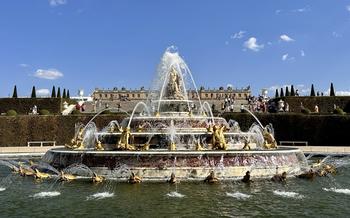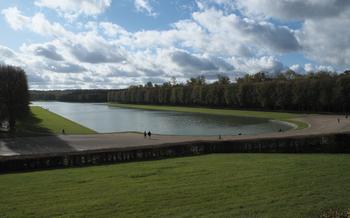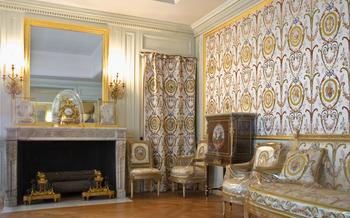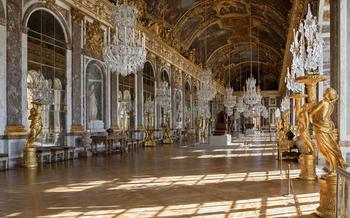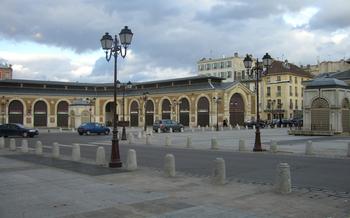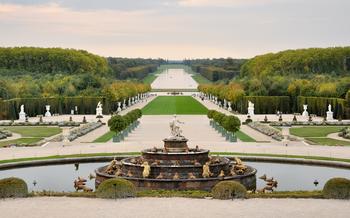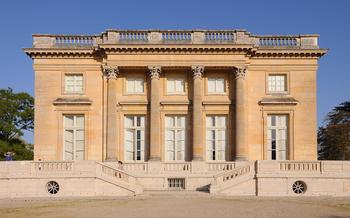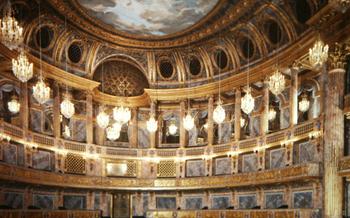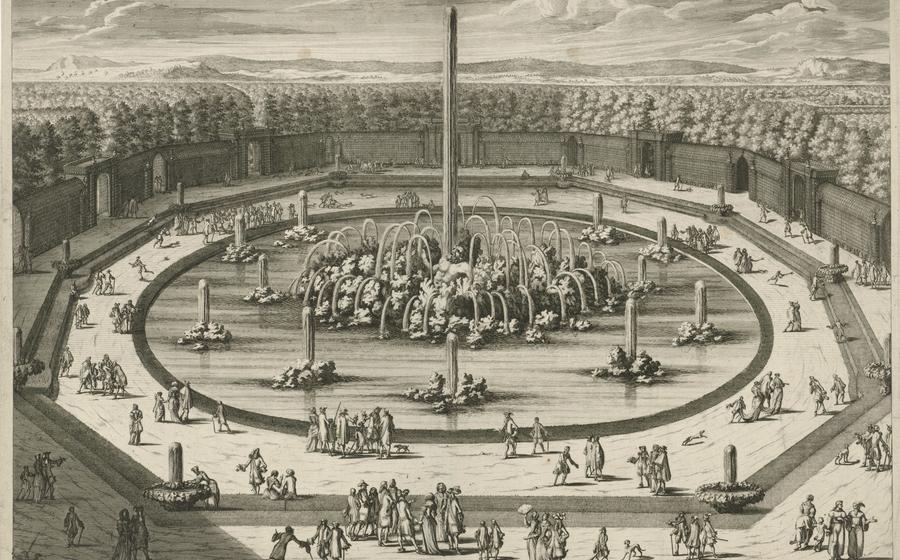
Enceladus Fountain
- Historical Background
- Mythological Symbolism
- Artistic Design
- Water Features
- Restoration and Conservation
- Location and Access
- Visiting Tips
- Nearby Attractions
- Special Events
- Art and Architecture Appreciation
- Historical Context
- Nature and Landscape
- Cultural Impact
- Insider Tip
Historical Background
The Palace of Versailles, a majestic testament to French grandeur, was once the opulent residence of the French monarchy. Its construction, commissioned by King Louis XIV, also known as the Sun King, was a testament to his desire to establish an awe-inspiring seat of power. Among the many wonders that adorn the palace grounds, the Enceladus Fountain stands as a captivating masterpiece, a symbol of Louis XIV's reign and his vision for Versailles.
The gardens of Versailles, designed by the renowned landscape architect André Le Nôtre, were meticulously crafted to complement the palace's grandeur. Le Nôtre's vision transformed the natural landscape into a breathtaking spectacle, featuring intricate parterres, cascading fountains, and sculptures that harmoniously blended with the palace's architecture. The Enceladus Fountain, positioned at the heart of this verdant paradise, became a focal point that embodied the essence of royal power and artistic brilliance.
Mythological Symbolism
The Enceladus Fountain is steeped in mythological symbolism, drawing inspiration from the ancient Greek myth of the giant Enceladus. According to legend, Enceladus, one of the Gigantes, waged war against the gods of Olympus, led by Zeus. During the battle, Enceladus was struck down by Zeus' thunderbolt and buried beneath Mount Etna. However, the vengeful giant continued to writhe and struggle beneath the earth, causing earthquakes and eruptions.
Louis XIV, the Sun King, identified with the figure of Enceladus, seeing in him a symbol of his own power and authority. The fountain's central sculpture depicts Enceladus, half-buried beneath a massive rock, straining against his bonds and spewing water from his mouth, representing his defiance and the untamed forces of nature.
Water, in the context of the fountain, holds profound symbolic meaning. It represents the power and control of the monarchy, mirroring Louis XIV's absolute rule over France. The gushing water jets, reaching impressive heights, symbolize the king's authority and his dominion over his subjects. The cascading water also evokes the idea of abundance and fertility, essential elements for the prosperity of the kingdom.
Furthermore, the fountain's association with the sun, through Louis XIV's identification with Apollo, the sun god, adds another layer of symbolism. The radiant sun, often depicted in the iconography of the Sun King, represents his divine authority and his role as the center of the universe, just as the sun is the center of the solar system. The fountain's water jets, reaching towards the sky, can be seen as a representation of the sun's rays, further emphasizing Louis XIV's association with the celestial body.
Artistic Design
The Enceladus Fountain is a masterpiece of the Baroque style, characterized by its grandeur, drama, and intricate ornamentation. The fountain's design is attributed to André Le Nôtre, the renowned landscape architect who played a pivotal role in shaping the gardens of Versailles.
-
Baroque Style: The Baroque style, popular in the 17th and 18th centuries, is known for its elaborate ornamentation, dynamic compositions, and the use of perspective to create a sense of depth and grandeur. These elements are evident in the Enceladus Fountain, which features intricate sculptures, cascading water jets, and a carefully orchestrated arrangement of basins and terraces.
-
Sculpture: The fountain is adorned with exquisite sculptures depicting Enceladus, the giant from Greek mythology, struggling against the gods. The central figure of Enceladus, carved from white marble, is a powerful and dynamic representation of the giant's struggle. The surrounding sculptures, including water nymphs and tritons, add movement and energy to the composition.
-
Perspective: The Enceladus Fountain is positioned at the end of a long vista, creating a dramatic perspective that draws the viewer's eye towards the fountain. The use of perspective enhances the sense of grandeur and spectacle, making the fountain a focal point of the gardens.
Water Features
The Enceladus Fountain is a marvel of hydraulic engineering, showcasing the innovative waterworks that were a hallmark of the Baroque era. The fountain's water system, designed by the hydraulic engineer Antoine Francine, was a masterpiece of its time, capable of propelling water to impressive heights and creating a captivating display.
The fountain boasts over 200 water jets, each shooting water up to 50 feet into the air. These jets are arranged in a symmetrical pattern, creating a mesmerizing spectacle of water and movement. The basins of the fountain are also carefully designed to enhance the visual effect, with water cascading down from the upper basins to the lower ones, creating a sense of depth and grandeur.
The Enceladus Fountain is a testament to the ingenuity and creativity of the engineers and artisans who worked on its construction. Its innovative hydraulic system, combined with the artistic design and symbolism, make it a masterpiece of Baroque water art and a must-see attraction for any visitor to Versailles.
Restoration and Conservation
Despite its grandeur and resilience, the Enceladus Fountain has faced the challenges of time and neglect. The fountain underwent a comprehensive restoration project in the 20th century to restore it to its original glory. The restoration team meticulously cleaned and repaired the sculptures, replaced missing pieces, and upgraded the hydraulic system to ensure its continued functionality.
One of the primary challenges in restoring the fountain was maintaining its authenticity. The team used traditional techniques and materials to ensure that the restored fountain remained faithful to its original design. They carefully studied historical documents and consulted with experts to ensure that every detail was accurate.
The restoration project was a remarkable success, and the Enceladus Fountain now stands as a testament to the skill and dedication of the restoration team. It continues to captivate visitors with its grandeur and beauty, serving as a reminder of the enduring legacy of the Palace of Versailles.
Location and Access
Nestled amidst the sprawling Gardens of Versailles, the Enceladus Fountain occupies a prominent position along the Grand Canal. To reach this remarkable water feature, visitors can embark on a leisurely stroll through the gardens, following the picturesque paths that lead to the fountain's grandeur. Alternatively, a short walk from the palace will bring you to the fountain, allowing you to immerse yourself in its beauty and symbolism.
For those with accessibility concerns, the Gardens of Versailles offer wheelchair-friendly paths and ramps, ensuring that everyone can marvel at the Enceladus Fountain's majesty. Additionally, visitors can take advantage of the informative signage throughout the gardens, providing historical context and insights into the fountain's significance.
Visiting Tips
For the best experience, plan your visit to the Enceladus Fountain during the warmer months when the water displays are in full force. Early mornings or late afternoons offer the most favorable lighting conditions for capturing stunning photographs of the fountain and the surrounding gardens. Allocate at least 30 minutes to fully appreciate the fountain's grandeur and intricate details. Take advantage of the informative signage near the fountain to learn more about its history and symbolism. Capture the fountain's magic in your photos, but remember to respect the other visitors and the tranquility of the gardens. For a unique perspective, consider taking a guided tour of the gardens, which often includes insights into the fountain's significance and design.
Nearby Attractions
Beyond the Enceladus Fountain, the Gardens of Versailles offer a wealth of other attractions to explore. The Palace of Versailles itself is a must-see, with its opulent interiors, grand halls, and fascinating history. Take a guided tour to delve into the lives of the French monarchs who once resided here and admire the stunning artwork, furniture, and tapestries that adorn the palace rooms.
Strolling through the meticulously manicured gardens, you'll discover a variety of other fountains, sculptures, and architectural follies. Don't miss the Grand Trianon, a smaller palace built for Louis XIV as a retreat from court life, and the Petit Trianon, a charming palace built for Marie Antoinette. These smaller palaces offer a more intimate glimpse into the lives of the French royals and their families.
For a unique perspective on the gardens, rent a bicycle and explore the winding paths at your own pace. Bicycles can be rented at the entrance to the gardens, and there are designated bike paths that allow you to cycle safely through the grounds.
No visit to Versailles is complete without a visit to the Hall of Mirrors, a magnificent gallery lined with floor-to-ceiling mirrors that reflects the gardens' beauty. This iconic hall was the setting for many important historical events, including the signing of the Treaty of Versailles in 191
Whether you're interested in history, art, architecture, or simply enjoying a leisurely stroll through beautiful gardens, the Gardens of Versailles offer something for everyone. Be sure to set aside plenty of time to explore all that this UNESCO World Heritage Site has to offer.
Special Events
The Enceladus Fountain offers a range of special events and attractions that enhance the visitor experience. During the summer months, the fountain comes alive with mesmerizing fountain shows that showcase the interplay of water, music, and light. These spectacular displays are a feast for the senses, offering a unique perspective on the fountain's grandeur.
In the evenings, the fountain transforms into a magical sight as it is illuminated with colorful lights. The interplay of water, light, and music creates an enchanting atmosphere that transports visitors to a bygone era. The night illuminations offer a different perspective on the fountain, allowing visitors to appreciate its beauty in a new light.
Occasionally, the fountain also serves as a stage for musical performances and events. These concerts and shows provide a delightful backdrop for enjoying the fountain's beauty while immersing oneself in the enchanting atmosphere of the gardens.
Art and Architecture Appreciation
The Enceladus Fountain is not just a water feature; it is a masterpiece of Baroque art and architecture. The Baroque style, which originated in 16th-century Italy, is characterized by its grandeur, drama, and use of intricate ornamentation.
-
Baroque Masterpiece: The fountain exemplifies the Baroque style with its elaborate sculptures, dynamic composition, and use of water as a dynamic element. It is a testament to the skill and artistry of the craftsmen and artists who created it.
-
Symbolism and Allegory: The fountain is rich in symbolism and allegory. The giant Enceladus represents the forces of chaos and disorder, while the gods symbolize order and reason. The fountain's message is clear: that order and reason will ultimately triumph over chaos and disorder.
-
Artistic Collaboration: The fountain was a collaborative effort between artists, sculptors, and engineers. The sculptor Gaspard Marsy created the intricate sculptures, while the engineer Antoine Francine designed the hydraulic system that powers the fountain. This collaboration resulted in a masterpiece that is both visually stunning and technically impressive.
Historical Context
The Enceladus Fountain stands as a testament to the reign of Louis XIV, the Sun King, and his grand vision for Versailles. It embodies the extravagance and opulence of the French monarchy during the 17th century. Louis XIV sought to create a palace and gardens that would surpass all others in Europe, a testament to his power and prestige. The Enceladus Fountain, with its majestic scale and intricate design, played a crucial role in realizing this vision.
The fountain was conceived as a symbol of the king's absolute power and his dominion over nature. The choice of Enceladus, the giant who dared to challenge the gods, as the fountain's central figure was a deliberate statement of Louis XIV's own authority. The fountain's placement at the heart of the gardens, commanding attention from all angles, further reinforced this message.
The Enceladus Fountain is not merely a work of art; it is a historical artifact that offers a glimpse into the grandeur and ambition of the French monarchy. It is a reminder of a time when kings ruled with absolute power and sought to immortalize their legacy through architectural marvels.
Nature and Landscape
The Enceladus Fountain is not merely an artistic masterpiece; it is also an integral part of the meticulously designed landscape of Versailles. The fountain's harmonious integration with the surrounding gardens and water features creates a captivating natural spectacle. The lush greenery, vibrant flowers, and tranquil waters provide a serene backdrop to the fountain's grandeur.
The fountain's location at the end of the Grand Canal, framed by rows of trees, enhances its visual impact. The water jets, shooting high into the air, create a mesmerizing display that contrasts with the stillness of the surrounding gardens. The interplay of water, light, and greenery creates a magical atmosphere that transports visitors to a realm of beauty and tranquility.
Beyond its aesthetic appeal, the fountain also holds environmental significance. Water has always been a vital element in the gardens of Versailles, symbolizing power, control, and abundance. The Enceladus Fountain embodies this symbolism, representing the mastery of nature and the ability to harness its resources for both practical and aesthetic purposes.
The fountain's design reflects the Baroque fascination with nature and its untamed power. The giant Enceladus, struggling against the force of the water, represents the futility of opposing the forces of nature. At the same time, the fountain's controlled and orderly display of water demonstrates humanity's ability to tame and harness these forces for its own purposes.
The Enceladus Fountain stands as a testament to the harmonious coexistence of art and nature. It invites visitors to contemplate the beauty of the natural world while marveling at the ingenuity and creativity of human artistry.
Cultural Impact
The Enceladus Fountain has left an indelible mark on the cultural landscape of France and beyond, inspiring artists, writers, and musicians throughout history. Its beauty and grandeur have captivated countless visitors, leaving them in awe of its artistic and historical significance. The fountain has become a beloved symbol of French cultural heritage and national pride, representing the country's rich artistic traditions and its enduring legacy in the world of art and architecture.
The fountain's fame has spread far beyond the borders of France, garnering international recognition as a masterpiece of art and architecture. Its unique design and captivating story have made it a popular subject for artists, who have depicted it in paintings, sculptures, and other forms of art. Writers have also been inspired by the fountain, using it as a setting or a source of inspiration for their works. The fountain's enduring legacy is a testament to its profound impact on culture and society, solidifying its place as a beloved and iconic landmark that continues to captivate and inspire generations.
Insider Tip
For a unique perspective of the Enceladus Fountain, venture beyond the main paths and discover a hidden gem nearby. The Bosquet de la Colonnade, located just a short walk from the fountain, offers a secluded spot to admire its grandeur from a different angle. Framed by a colonnade of marble columns and surrounded by lush greenery, this viewpoint allows you to appreciate the fountain's intricate details and its harmonious relationship with the surrounding gardens. Take a moment to sit on one of the benches and soak in the tranquility of this hidden oasis, where you can fully appreciate the artistry and majesty of the Enceladus Fountain.
